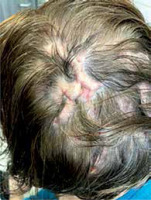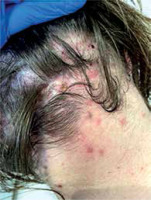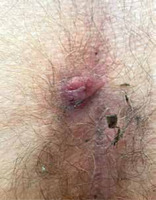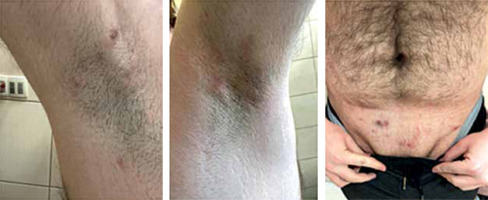Hidradenitis suppurativa (HS) is a chronic inflammatory disease with a complex pathogenesis, in which the key role is played by hyperkeratosis within the hair follicle openings. This process leads to follicle occlusion, rupture, and subsequent inflammation resulting in the formation of painful nodules, abscesses, and the development of subcutaneous tunnels, sinuses and scarring.
The main areas affected by the disease are those rich in apocrine sweat glands, such as the armpits, groin, breast folds, perianal area, and buttocks [1]. The disease affects about 1% of the population, with a higher incidence in women than in men (except in the perianal area), mainly between the ages of 20 and 40 [2]. HS may coexist with other diseases involving hair follicle occlusion, such as acne conglobata, dissecting cellulitis of the scalp, and pilonidal cyst. Together, they make up the follicular occlusion tetrad [3]. The purpose of this article is to present the case of a 19-year-old male patient whose entire clinical features indicated the presence of a follicular occlusion tetrad. Due to the lack of documented cases and treatment guidelines, management of the disease typically involves personalized and multidisciplinary approaches.
A nineteen-year-old male patient was referred to the Dermatology Clinic due to hidradenitis suppurativa, which he has been suffering from for about 3 years. Upon admission, subcutaneous abscesses with retracted scars were present in the armpit and groin area with purulent cystic lesions in the lower abdomen (Figure 1). In the area of the scalp, purulent nodules forming tunnels and sinuses were prominent (Figure 2), and purulent pustules were present in the occipital region (Figure 3). Acne lesions with ice pick type scars were present on the face (Figure 4) with ordinary acne on the back. A pilonidal cyst-like lesion was present above the anal cleft (Figure 5). The whole clinical picture indicated the presence of a follicular occlusion tetrad – hidradenitis suppurativa, acne conglobata, dissecting cellulitis of the scalp, and pilonidal cyst.
Figure 1
Subcutaneous abscesses with retracted scars in the axilla and groin areas, and purulent cystic lesions in the lower abdomen

The patient had been previously treated on an outpatient basis with orally administered clindamycin and locally applied gentamicin and shampoo with ichthammol. Additionally, the patient was obese (113 kg, body mass index (BMI) 32.31 kg/m2) and taking allopurinol for hyperuricemia. Laboratory tests performed during hospitalization revealed slightly elevated inflammatory parameters (CRP 13 mg/l, thrombocytosis 493,000/µl, ESR 26 mm/h). The parameters of lipid and carbohydrate metabolism remained within the normal range (fasting glucose 94 mg/dl, triglycerides 85 mg/dl, total cholesterol 137 mg/dl, LDL 82 mg/dl, HDL 41 mg/dl). Blood pressure measurements during hospital assessments were within the range of 120–130/80–85. The patient has never engaged in smoking. Mental condition was assessed by scales such as DLQI – 4 points, HiSQOL – 7 points, which means a low impact on the patient’s life, and HADS-M scale – which was obtained for the anxiety component – 8 points, for the depression component – 4 points. The total score on the HADS-M scale is 12, which is interpreted as moderate psychological distress. The patient remains under the continuous care of a psychological clinic.
During hospitalization, intravenous therapy with doxycycline at a dose of 100 mg twice a day and locally applied mupirocin ointment was initiated. For further outpatient treatment, isotretinoin was prescribed at a dose of 30 mg/day, clindamycin 300 mg twice per day, rifampicin 300 mg twice per day, a probiotic, and acetylsalicylic acid 75 mg/day due to thrombocytosis. For local treatment, due to good tolerance of ichthammol preparations, a cream with ichthammol was prescribed for use after pre-disinfecting the lesions with sodium hypochlorite solution and a shampoo with ichthammol for washing the scalp.
The combination of clindamycin and rifampicin was used for 3 months, and due to good tolerance and a positive clinical response, the treatment was extended to 6 months. During this period, the scalp lesions were treated with four intralesional injections of methylprednisolone, resulting in nearly complete resolution of the skin lesions (Figure 6). Remission of lesions in the armpit area and lower abdomen (Figure 7) was also achieved. In the subsequent treatment, oral antibiotic therapy was discontinued, and the patient continued to receive isotretinoin at a dose of 30 mg/day along with topical clindamycin.
Figure 6
Nearly complete resolution of skin lesions after treatment with four intradermal injections of methylprednisolone

The exact pathogenesis of this group of diseases is unknown, but evidence points to the existence of a single pathological process that is initiated by hair follicle occlusion [4]. The onset of the disease occurs with the involvement of both genetic and environmental factors. Some patients have mutations in genes of the γ-secretase pathway inherited in a monogenic manner, but for the majority, the genetic factor remains unknown. The risk of a severe course of the disease increases with higher BMI values, associated with both increased friction within skin folds and chronic inflammation triggered by adipose tissue hormones. Nicotine use contributes to the development of the disease by enhancing perifollicular keratinization and cytokine production by keratinocytes, as well as impeding the healing of skin lesions. Secondary bacterial colonization worsens the course of the disease. Furthermore, patients with hidradenitis suppurativa are at risk of developing components of the metabolic syndrome [5]. According to the International Diabetes Federation, starting from 2005, metabolic syndrome can be diagnosed when central obesity is present, plus at least 2 of 4 additional criteria are fulfilled: hypertriglyceridemia (≥ 150 mg/dl [1.7 mmol/l]); reduced HDL concentration (< 40 mg/dl [1.03 mmol/l] in men and < 50 mg/dl [1.29 mmol/l] in women); arterial hypertension (systolic blood pressure ≥ 130 mm Hg or diastolic blood pressure ≥ 85 mm Hg); raised fasting plasma glucose concentration (≥ 100 mg/dl [5.6 mmol/l]) or previously diagnosed type 2 diabetes – these criteria are also met if the patient is taking medication for the above reasons [6]. In the presented case, the only risk factor for the disease was obesity. The patient did not meet the criteria for diagnosing metabolic syndrome, and the nicotine history was negative. Hair follicle occlusion tetrad can be extremely difficult to treat, and it presents an unusual challenge for even experienced clinicians. Acne conglobata (AC) is a rare, chronic inflammatory disease that belongs to the severe form of nodulocystic acne. It usually manifests itself with tender, disfiguring blackheads, cysts, inflammatory nodules and deep abscesses on the face, shoulders, back, chest, arms, buttocks and thighs. Blackheads often appear in groups of three, and cysts often contain purulent, stinky material that leaks onto the surface of the skin [7]. AC lesions regress, leaving scars and deformities. AC requires aggressive treatment due to the degree of inflammation and the formation of deep nodules and cysts [8]. The treatment of choice for AC is oral retinoids, mainly isotretinoin. Temporary addition of oral prednisone after starting isotretinoin may be considered [9]. Topical retinoids are not as effective as oral retinoids, but can be used as an adjunct. Pilonidal disease is a common purulent condition that is localized under the skin of the sacrococcygeal region. Treatment of the pilonidal cyst in the vast majority of cases is based on surgery, the goal of which is to eliminate abscesses, heal as quickly as possible and reduce recurrence as much as possible [10]. Treatment of hidradenitis suppurativa still remains controversial. Traditionally, oral antibiotic therapy is used, and the best-studied regimen is the combination of clindamycin 600 mg/day and rifampicin 600 mg/day [11]. Oral tetracyclines are also considered, but it should be remembered that they cannot be combined with retinoids as this may lead to increased intracranial pressure. In milder forms of Hurley stage I/II, a 1% clindamycin cream or gel can be used [12]. Antibiotic therapy should be continued for 3 months, and if it is effective, re-introduction of the therapy can be considered in case of relapse. Microbiological examination of skin lesions is not recommended. Retinoids are not very effective in the treatment of hidradenitis suppurativa, but they can be helpful in treating acne conglobate [13]. Dissecting cellulitis of the scalp (DCS) is a chronic inflammatory skin condition characterized by abscesses, nodules, fistulas and scarring alopecia [14]. Treatment of this often debilitating dermatosis can be difficult due to its refractory nature. The standard of care for the treatment of dissecting cellulitis, which has demonstrated high efficacy, involves the administration of oral isotretinoin. However, it should be noted that relapses are frequent following the discontinuation of treatment [15]. In milder cases, topical corticosteroid therapy or intralesional corticoids may be considered as therapeutic options. Oral corticosteroid therapy is less commonly employed and is primarily used as a bridging treatment before the initiation of other medications, such as retinoids or biologics. In the management of exacerbations, oral antibiotic therapy with clindamycin and rifampicin is frequently employed. There have also been attempts to explore treatment options such as photodynamic therapy, ablative lasers, and ND:Yag lasers. In severe cases, surgical intervention may be warranted [16, 17]. In recent years, promising results in the treatment of hidradenitis suppurativa have been achieved through research on biologic drugs. The best-studied drug is adalimumab, but in single case reports, improvement in the course of hidradenitis suppurativa has been shown for infliximab, secukinumab, certolizumab, tildrakizumab, ixekizumab, and brodalumab [18].
Assessing mental status and psychological well-being is an extremely important aspect regarding the comprehensive diagnosis and treatment of HS patients as the impact of HS was rated by the researchers as having a great or very great impact on the patient’s life in about 60% of the patients studied [19]. The DLQI results clearly indicate that anogenital localization is of great importance. One in 5 patients was shown to be at risk for comorbid depression, making HS a disease with a high risk of developing this disorder. HS affects a broad spectrum of psycho-physical aspects (including fatigue, levels of depression and stigma, and overall patient activity) and the deterioration of the associated quality of life. The severity of the disease is the most important factor negatively affecting patients’ well-being. Also, the specific location – anogenital – seems to impair the quality of life of HS patients the most, while it is worth noting that the presence of lesions on exposed skin plays a key role in the level of stigmatization of these patients. Therefore, a comprehensive interdisciplinary approach to the treatment of patients with hair follicular occlusion tetrad, an approach that takes into account psychological aspects, is a key element of effective therapy among these patients, which has implications for clinical well-being and quality of life in this group.
In conclusion, the described patient exhibited all elements of the follicular occlusion tetrad. Hidradenitis suppurativa is a chronic disease that significantly affects the patient’s quality of life and daily functioning. Therefore, early diagnosis of the disease and active observation to detect associated diseases and implement appropriate treatment to prevent complications is crucial. The coexistence of HS with other follicular occlusion disorders adds complexity to the clinical picture, emphasizing the need for a comprehensive and individualized approach to treatment. Further research and clinical trials on biologic drugs will continue to shape the landscape of HS management, offering hope for improved outcomes for those affected by this challenging condition.













